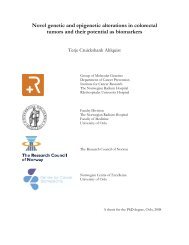Preface - Ous-research.no
Preface - Ous-research.no
Preface - Ous-research.no
Create successful ePaper yourself
Turn your PDF publications into a flip-book with our unique Google optimized e-Paper software.
Cell Transplantation<br />
ted source for xe<strong>no</strong>transplantation, still, IBMIR and other<br />
factors that hamper the success of allo-islet transplantation<br />
will remain. The intramuscular site allows manipulation of<br />
the graft and the implantation site prior to transplantation<br />
and could easily be excised if necessary (Fig. 5 ). We have<br />
shown that islet transplantation into striated musculature<br />
is feasible, however, in its present form the intramuscular<br />
site is less efficient compared to the liver. Ex vivo manipulation<br />
of islets is discussed, especially coating of the islets<br />
with mesenchymal and endothelial cells from the recipient<br />
and thus reducing the antigen presentation of islets after<br />
transplantation. Explorative studies on striated musculature<br />
as a potential site for islet transplantation is defined in a PhD<br />
program (Kristine Kloster-Jensen).<br />
Project 4. In vivo surveillance of transplanted islets<br />
Transplanted islet cell mass is <strong>no</strong>t static but changes in<br />
response to the environment, e.g. inflammation at the transplant<br />
site, toxicity of immu<strong>no</strong>suppressants and influence by<br />
the immune system. Non-invasively monitoring of changes<br />
in islet mass following islet transplantation is important to<br />
provide new insight into factors regulating post transplant<br />
function. The <strong>research</strong> group is exploring two different approaches<br />
for post transplant islet mass surveillance.<br />
4.1 Bioluminescent in vivo imaging<br />
Recently, in collaboration with the Transplantation Research<br />
Laboratory, UCSF (Dr. Hanne Scholz) the transgenic mouse<br />
stock, insulin I promoter (MIP-luc) has been imported to our<br />
laboratory. In these mice, luciferase-expressed beta cells is<br />
visualized by bioluminescent imaging and has been shown<br />
to correlate with beta cell mass (Fig. 6 ). Thus, this <strong>no</strong>n-invasive<br />
model can be utilized to monitor changes in beta-cell<br />
mass over time in individual animals. The bioluminescent<br />
imaging technique is an important tool for the <strong>research</strong><br />
in islet transplantation, and is implicated in many of the<br />
ongoing studies.<br />
4.2 PET in vivo imaging<br />
Pancreatic islet cell engraftment, distribution, function<br />
and survival can be visualized by PET in vivo imaging. The<br />
application of the PET tech<strong>no</strong>logy in clinical islet transplantation<br />
takes advantage of the recent rapid development of<br />
<strong>no</strong>n-invasive imaging tech<strong>no</strong>logy in a new area of medicine.<br />
The aim of this project is to obtain a new unique method to<br />
acquire detailed k<strong>no</strong>wledge of the engraftment process of<br />
intraportal implanted islets in man.<br />
Hepatocytes<br />
General objectives<br />
Uppsala university/Karolinska institute/Oslo University<br />
(Institute for Surgical Research)<br />
••<br />
Approaches to overcome the Instant Blood-Mediated<br />
Inflammatory Reaction (IBMIR) induced by hepatocytes at<br />
the time of transplantation.<br />
••<br />
Enhancement of hepatocyte engraftment by LMW-DS<br />
induced HGF<br />
••<br />
Development of a clinically applicable imaging technique<br />
for the evaluation of hepatocyte engraftment.<br />
Figure 6. Bioluminescent in vivo imaging.<br />
Background<br />
Whole organ liver transplantation (Ltx) is standard clinical<br />
treatment for patients with acute and chronic liver diseases<br />
and even for selected patients with primary and secondary<br />
liver tumors. However, due to organ shortage a significant<br />
number of patients are dying on the waiting list. Several<br />
initiatives such as split-liver (one liver for two recipients) and<br />
live do<strong>no</strong>r transplantation have been introduced to reduce<br />
the waiting lists for Ltx. However, additional approaches are<br />
necessary to overcome pretransplant mortality. Experimental<br />
studies and some clinical trials have shown that hepatocyte<br />
transplantation may be useful in patients as a bridge to<br />
Ltx or while waiting for the liver to regenerate (acute toxic<br />
liver failure). In selected patients with single enzymatic defects,<br />
hepatocyte transplantation may even heal the disease.<br />
More than 200 patients with acute and chronic liver failure<br />
35
















